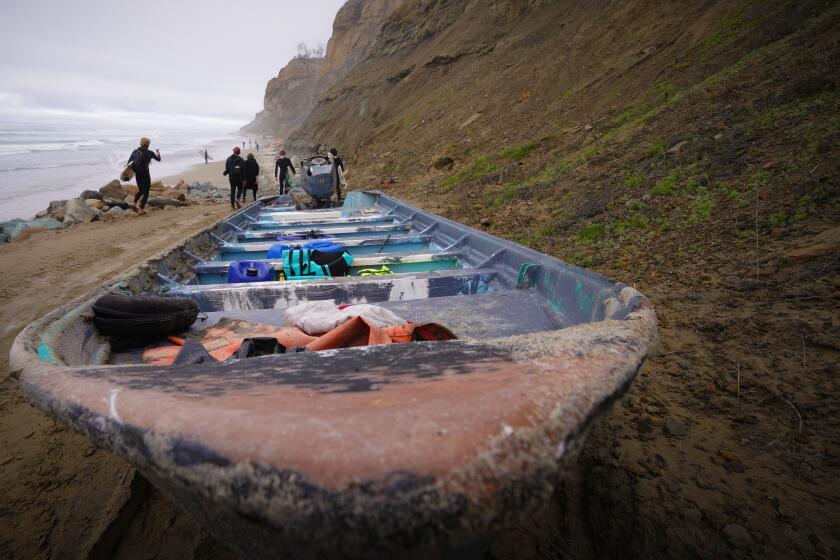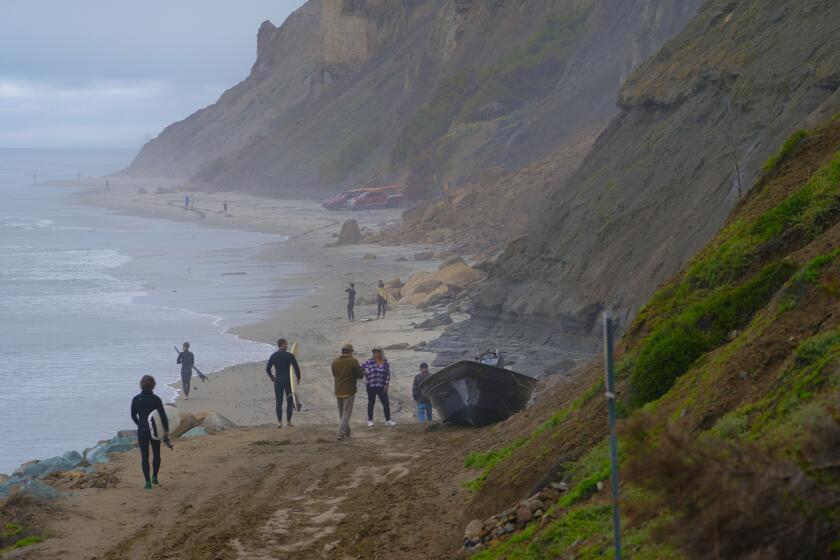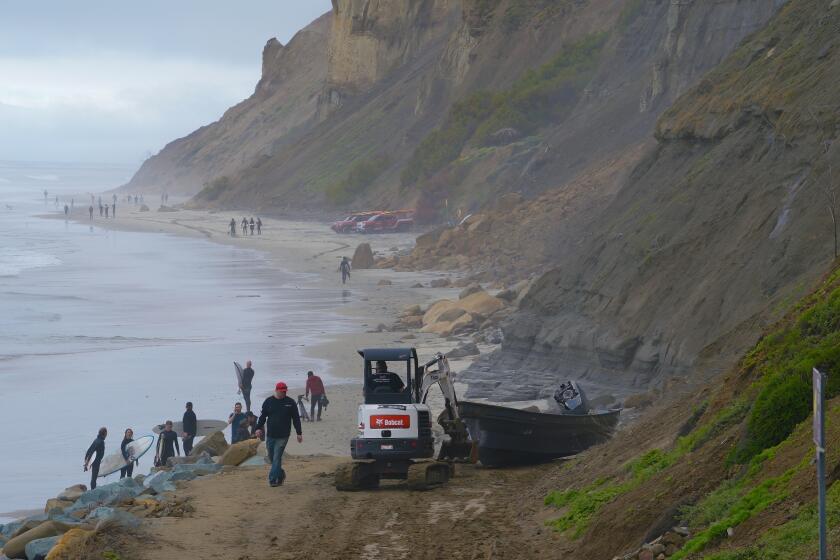8 reported dead after 2 suspected smuggling boats crash at Black’s Beach in San Diego

Officials said one of the boats reportedly capsized off Black’s Beach, south of the Torrey Pines Gliderport, shortly before midnight.
SAN DIEGO — At least eight people died when two migrant smuggling boats overturned late Saturday in the shallow but formidable surf along the coast of San Diego, a tragedy that ranks among the deadliest maritime smuggling incidents in U.S. history.
Officials were alerted to the deadly operation when a woman called 911 around 11:30 p.m. asking for help. She had been with seven others on a boat that made it to shore at Black’s Beach, near La Jolla. The woman, who spoke Spanish, told authorities that a second boat with up to 15 people aboard had capsized nearby.
When emergency crews arrived at the shore, they found both boats capsized and did not encounter any survivors, including the 911 caller, said Lifeguard Chief James Gartland of the San Diego Fire Department.
“This is one of the worst maritime smuggling tragedies that I can think of in California and certainly here in the city of San Diego,” Gartland said.
A lifeguard dispatcher used GPS coordinates from the woman’s cellphone to pinpoint the exact location, ultimately drawing rescuers just south of the Torrey Pines Gliderport. Lifeguards unable to access the beach because of high tide ended up wading north through knee- to waist-deep water, officials said.
“After a couple hundred yards, lifeguards on the beach reached dry sand and then began to find lifeless bodies and two overturned pangas spread over an area of about 400 yards,” a statement from the San Diego Fire-Rescue Department said. “Several life jackets and fuel barrels were also found.”
A Coast Guard helicopter was the only aircraft able to make it to the area because of the fog and other weather conditions, and the poor visibility hampered the search effort.
“They couldn’t see the water very well, even with night-vision goggles,” said Coast Guard Capt. James Spitler, the commander of the Coast Guard’s San Diego sector. “They did a few legs of the search pattern and determined that the risk exceeded their ability to do a search effectively, so they returned to base.”
Crews on the ground worked through the early hours of Sunday morning, amid thick fog and high tides, to recover those who perished. Officials confirmed they had pulled eight bodies from the area. All of the victims were adults.
“We did the best we could to recover people from the water,” said Gartland, who did not know how many people may have survived or how many bodies remained to be retrieved from the ocean.
Officials did not provide the age, gender or nationality of any of those who died. The bodies were turned over to the San Diego County Medical Examiner’s Office to be identified.
Carlos González Gutiérrez, the consul general of Mexico in San Diego, expressed sorrow for “the tragedy that occurred this morning near La Jolla,” according to a statement posted online. “We are working to identify people of Mexican origin and assist their families.”
Coast Guard and San Diego Fire-Rescue helicopters and a Coast Guard cutter combed the area for additional victims early Sunday. Black’s Beach is jointly owned by the city of San Diego and the state.
Smugglers often favor weather conditions like Saturday night, when poor visibility helps evade detection as they travel up the coast from Mexico,with overloaded boats and poor maintenance adding to the danger.
“It’s very difficult for anybody to operate in those conditions,” Spitler said. “They were likely one of the very few mariners out there at sea.”
The harrowing boat rides from Mexico to the Southern California coast, which cost up to $20,000 per passenger, according to experts, have increased in frequency in recent years.
Spitler told reporters at a morning news conference that there’s been a 771% increase in human trafficking in the Southern California coastal region since 2017.
“Since 2021, we’ve had 23 lives lost at sea,” he said, cautioning that the true number of those who have died in smuggling boats is unknown.
In 2021, three people died — a man and two women — and 32 survived when a 40-foot panga boat crashed into rocks at the base of the cliffs of Point Loma in San Diego. The same year, one migrant drowned and 10 others were rescued after a smuggling boat crashed off the coast of La Jolla. Two men who led that expedition were later sentenced to federal prison.
“There has been a substantive increase in maritime crossings over the last three years, and I believe it’s related to that many migrants don’t have the ability to turn themselves in at the ports of entry,” said Pedro Rios, director of the American Friends Service Committee’s U.S./Mexico Border Program. “They’ve become frustrated and seek out dangerous ways of crossing into the U.S.”
He and other immigration observers have cited the impact of Title 42, a Trump-era policy that ends in May that allows border agents to quickly turn back migrants, and other measures that limit people from seeking asylum. Rios also pointed to higher physical barriers along the border that “make it much more difficult for people to climb, so they seek out other ways,” including through the mountains, desert or ocean.
“This loss of life likely was preventable,” Rios said.
More to Read
Sign up for Essential California
The most important California stories and recommendations in your inbox every morning.
You may occasionally receive promotional content from the Los Angeles Times.

















